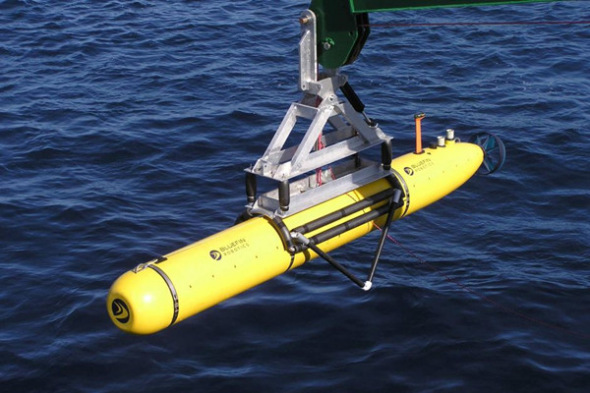

A Bluefin-21 autonomous underwater vehicle (AUV) has completed its first dive. (file photo)
US Navy's mini-submarine Bluefin-21 cut short its first underwater search for the Malaysian jet Tuesday after exceeding its programmed depth limit in the Indian Ocean. [Special coverage]
Of the 40 square km of search area initially planned for its first mission, 30 percent had been covered, but no discovery related to the missing flight MH370 was made, US Navy Captain Mark Matthews told Xinhua.
In an exclusive interview with Xinhua, Matthews said the Bluefin was launched at 5:20pm local time (0920 GMT) Monday and was recovered at 1 a.m. (1700 GMT Monday) on Tuesday.
"The area where the Bluefin was programmed for searching ranges from a depth of 4,200 to 4,400 meters, according to the chart ... Unexpectedly, we encountered an area that was deeper than 4,500 meters," Matthews said.
The unmanned sub, equipped with sonar gear, can operate within a maximum depth of 15,000 feet (4,500 meters). The Joint Agency Coordination Center (JACC) said Bluefin-21 exceeded that limit during its first mission and its built-in safety feature automatically returned it to the sea surface.
The initially assigned search area is a 5 km by 8 km rectangle. Matthews said Bluefin will search the area in seven lines that roughly go north to south.
During the first mission, Bluefin completed two lines, which covered 11.2 square km, or about 30 percent of the planned area, before it encountered the excessive depth of waters.
"Data from about 30 percent of the search area has been downloaded and reviewed. There was no sign of any evidence of the aircraft in that portion of the search area," Matthews said.
He said Bluefin had been reprogrammed with better instructions to prevent a similar mission abortion and to keep it operating within its limit.
"It will be put back into the water again later Tuesday when the sea state and wave height comes down to allow the safe deployment of the system," he said.
According to Matthews, the re-programming will keep Bluefin at a maximum depth of 4,500 meters as well as following the contour of the bottom. The autonomous underwater vehicle will keep an altitude of 30 meters above the sea floor until it hits that maximum depth.
From the data gathered by Bluefin, searchers had been made aware that the conditions of the sea floor are "relatively barren" with only a few rocks, and "the rocks are not characteristic of what you see would be an aircraft."
Bluefin-21 is programmed to take 24 hours to complete each mission: two hours to dive to the sea bottom, 16 hours to search the floor, two hours to return to the surface, and four hours to upload the data.
On Tuesday, nine military aircraft, two civilian ones and 11 ships assisted in the search for the missing flight.
Malaysia's acting transport minister, Hishamuddin Hussein, pledged Tuesday to reveal the full contents of the black boxes if they are found.
"It's about finding the truth. And when we ... find out the truth, definitely we have to reveal what's in the black box," Hussein told reporters in Kuala Lumpur. "So there is no question of it not being released."
Over the last two weeks, multi-national searchers have detected five signals linked to the black boxes, but time is running out as black box beacons had a life of around 30 days.
Australian Prime Minister Tony Abbott said last week he was "very confident" that the underwater signals were from the black boxes on Flight 370, which disappeared March 8 during a flight from Kuala Lumpur to Beijing with 227 passengers and 12 crew members on board.
Meanwhile, Australian coordinators were investigating an oil slick about 5,500 meters from the area where the last pings were detected. They have collected an oil sample and sent it back to Perth for analysis.
Another mystery emerged after a weekend report said that co-pilot Fariq Abdul Hamid's cellphone was on during flight and he tried to make a call with his cellphone after the plane was diverted from its scheduled route.
Malaysia has been tight-lipped about its ongoing investigation, saying that revelations could hinder further probe into the vanished flight.
Copyright ©1999-2018
Chinanews.com. All rights reserved.
Reproduction in whole or in part without permission is prohibited.